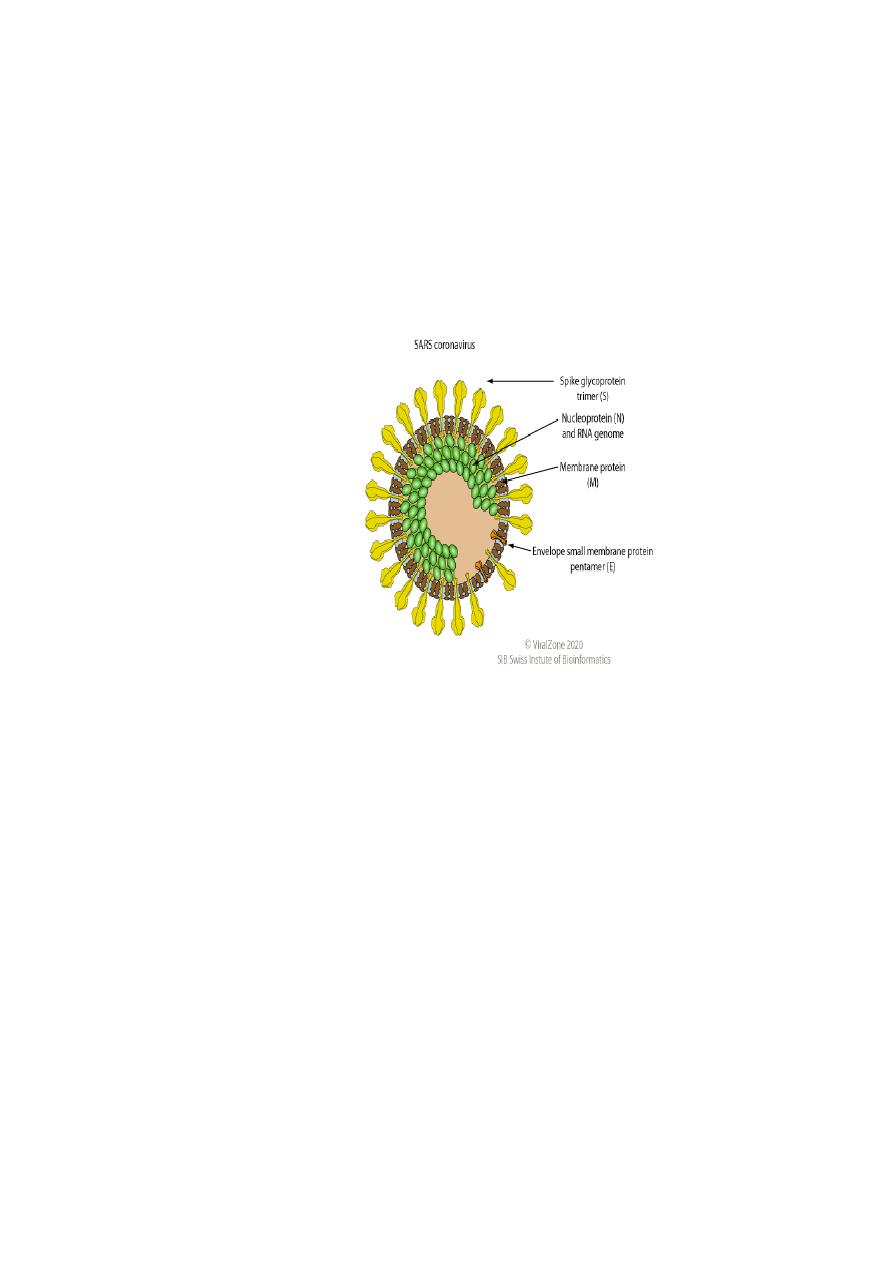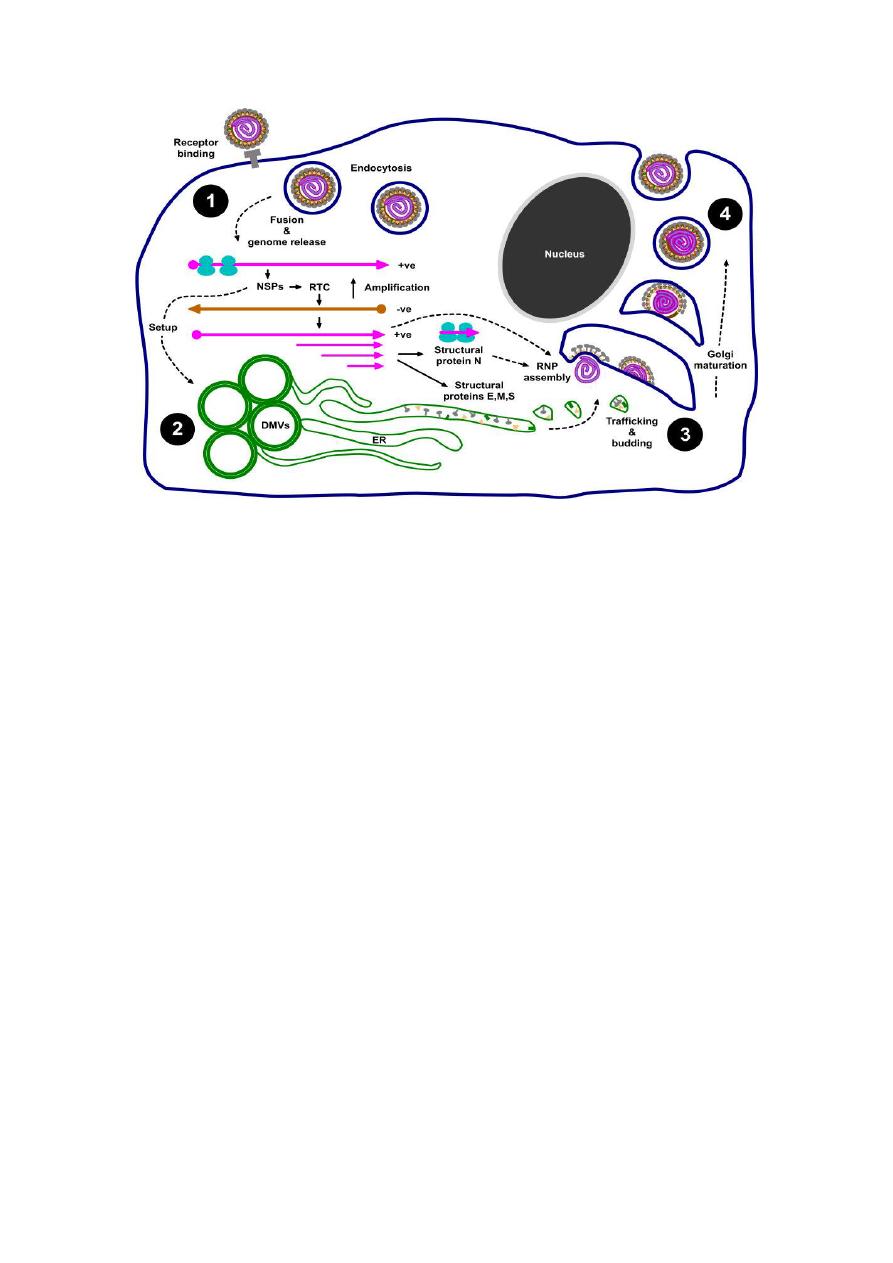
1
Coronaviruses
اﻟﻤﺮﺣﻠﮫ اﻟﺜﺎﻟﺜﮫ /ﻓﺎﯾﺮوﺳﺎت
د. اﻧﺘﻈﺎر ﻋﻼوي ﺟﻌﻔﺮ / ﻓﺮع اﻻﺣﯿﺎء اﻟﻤﺠﮭﺮﯾﮫ / ﻛﻠﯿﮫ اﻟﻄﺐ / ﺟﺎﻣﻌﮫ ذي ﻗﺎر
PhD. M.Sc. Microbiology
Introduction
Coronaviruses (CoVs) are enveloped +ve sense RNA viruses causing a variety of
diseases in man and animals. In Humans, several CoVs are known to cause
respiratory infections ranging from the common cold to more severe diseases.
CoVs are considered to be the largest of the RNA viruses, with genomes ranging
from 27-32 kb . Viruses of zoonotic potential are found within the coronaviruses
as exemplified by Severe Acute Respiratory Syndrome coronavirus (SARS-CoV)
which emerged in Southern China in 2003 , Middle East Respiratory Syndrome
(MERS-CoV), which appeared in Saudi Arabia in 2012 and the most recently
SARS-CoV-2 in Wuhan China in 2019 causing COVID-19 disease.
Coronavirus: from latin corona (crown), referring to the shape of spike protein
around the virion
Taxonomy of coronaviruses
Coronaviruses belong to the Coronaviridae family and contain two subfamilies
Orthocoronavirinae and Letovirinae. Along with six other families,
Abnidovirineae, Arnidovirineae, Cornidovirineae, Mesnidovirineae, Monidovirineae,
Ronidovirineae, and Tornidovirineae, they form the Nidovirales order. The
Coronaviridae are further subdivided phylogenetically into four genera, α, β, γ
and δ. There are seven members of the family of coronaviruses that infect
humans including HCoV-229E, human coronaviruses NL63, OC43, HKU1, SARS,
MERS and SARS-CoV-2.
SARS-CoV-2

2
Morphology
CoVs are enveloped, spherical positive single strand non-segmented RNA viruses
about 120 nm in diameter. They have the largest RNA genome of the RNA viruses
ranging from 25.4 kb to 31.8 kb. CoVs have four structural proteins including
spike (S), Membrane (M), envelope (E) and in some species such Mouse hepatitis
virus (HE) proteins . The +SS RNA genome is in association with N protein forms
a helical nucleocapsid . In addition to 16 non structural proteins (NSP).
Replication cycle (The replication cycle takes place in the cytoplasm of
cells)
v
Attachment of the viral S protein (maybe also HE if present) to host
receptors mediates endocytosis of the virus into the host cell.
v
Fusion of virus membrane with the endosomal membrane , ssRNA(+)
genome is released into the cytoplasm.
v
Synthesis and proteolytic cleavage of the replicase polyprotein.
v
Replication occurs in viral factories. A dsRNA genome is synthesized from
the genomic ssRNA(+).
v
The dsRNA genome is transcribed/replicated thereby providing viral
mRNAs/new ssRNA(+) genomes.
v
Synthesis of structural proteins encoded by subgenomic mRNAs.
v
Assembly and budding at membranes of the endoplasmic reticulum (ER),
the intermediate compartments, and/or the Golgi complex.
v
Release of new virions by exocytosis.

3
Clinical Syndromes
Most human coronaviruses cause mild acute upper respiratory tract illnesses
“colds” but a new coronaviruses causes severe acute respiratory syndrome
(SARS), Middle East respiratory syndrome (MERS) and severe acute respiratory
syndrome-CoV-2 (SARS-CoV-2).
Coronaviruses cause following syndromes:
(a ) Common cold,
(b ) Gastroenteritis
(c ) Severe Acute Respiratory Syndrome (SARS).
v
Common cold
The coronaviruses (229E and OC43-CoVs) cause more commonly upper
respiratory tract, and less commonly, lower respiratory tract illnesses in
humans. Common cold caused by coronaviruses has an incubation period of 3
days. The condition is characterized by rhinorrhea, sore throat, and low-grade
fever. The condition typically lasts for several days.
v
SARS is a potentially life-threatening infection associated with the onset
of flu-like syndrome, which may progress to pneumonia, respiratory
failure, and in some cases death.

4
v
SARS-CoV causes severe respiratory disease. The incubation period
averages about 6 days although it may be as long as 2 weeks.
v
Common early symptoms include fever, malaise, chills, headache,
dizziness, cough, and sore throat, followed a few days later by shortness
of breath. Many patients have abnormal chest radiographs.
v
Some cases progress rapidly to acute respiratory distress, requiring
ventilatory support.
v
Death from progressive respiratory failure occurs in almost 10% of cases,
with the death rate highest among the elderly.
v
SARS involves a cytokine storm, with elevated levels of multiple
chemokines and cytokines in the peripheral circulation for about 2 weeks.
Reservoir, source, and transmission of infection
u
Viruses of zoonotic potential are found within the coronaviruses as
exemplified by SARS, MERS and SARS-CoV-2 In these viruses, infection of
man is thought to have arisen by contact with an intermediate host which
in turn acquired the virus from the original reservoir, presumed to be
bats. The intermediate host For SARS 2003 is the civet cat, for MERS-CoV
the intermediate host is the dromedary camel, For SARS-CoV-2 the
intermediate host is unknown yet.
u
SARS is believed to be primarily transmitted by close person to- person
contact.
u
exposure to contaminated secretions from a SARS patient.
u
The infection would possibly have been acquired by inhalation of
infectious droplets coughing or sneezing, from a SARS patient. Moreover,
another possible mode of transmission is direct contact of the eyes, nose,
or mouth of susceptible individuals with infectious secretions of SARS
patients.
Laboratory diagnosis
Specimens: include respiratory samples such as nasopharyngeal swab for
isolation of virus and molecular diagnosis, and serum for testing of antibodies.
1-Molecular diagnosis using Real-time rRT-PCR using primers targeting CoV-N,
RdRp proteins.

5
2-Immunological assays such as ELIZA, immunofluorescent assay (IFA) are the
most frequently used tests for detection of specific antibodies in patients with
SARS during acute illness or 28 days and more after the onset of disease.
3- Virus isolation in tissue culture. Isolation of human coronaviruses in cell
culture has been difficult. However, the SARS and MERS, SARS-CoV-2 viruses
have been recovered from oropharyngeal specimens using different tissue
culture cells.
4-
Genomic sequencing for SARS-CoV-2 can be used to investigate the dynamics
of the outbreak. In addition and used to decide which diagnostic assays, drugs
and vaccines may be suitable candidates for further exploration
Inactivation of CoVs by disinfectant agents
Disinfectant agents effectively reduce coronavirus infectivity within 1 minute
such as
Ø
62% - 71% ethanol.
Ø
0.5% hydrogen peroxide
Ø
0.1% sodium hypochlorite
Treatment
For COVID-19 treatment, the FDA has approved the antiviral drug (remdesivir)
for adults and certain pediatric patients with COVID-19 who are sick enough to
need hospitalization.
There are currently more than 50 COVID-19 vaccine candidates in trials
Several different types of potential vaccines for COVID-19 are in development,
including:
•
Inactivated or weakened virus vaccines, which use a form of the virus that
has been inactivated or weakened so it doesn’t cause disease, but still
generates an immune response.
•
Protein-based vaccines, which use harmless fragments of proteins or
protein shells that mimic the COVID-19 virus to safely generate an
immune response.

6
•
Viral vector vaccines, which use a virus that has been genetically
engineered so that it can’t cause disease, but produces coronavirus
proteins to safely generate an immune response.
•
RNA and DNA vaccines, that uses genetically engineered RNA or DNA to
generate a protein that itself safely prompts an immune response.
Prevention and Control
v
Control measures that were effective in stopping the spread of SARS
included isolation of patients, quarantine of those who had been exposed,
v
Travel restrictions, as well as the use of gloves, gowns, goggles, and
respirators by health care workers.
v
Washing hands regularly with soap and water or clean with alcohol-based
hand rub.
